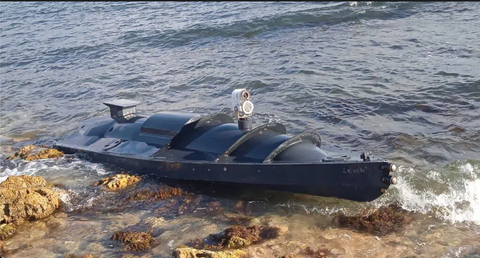
How Ukraine Turned a 12-Foot Boat Into a Floating Guided Missile
Since Russia launchedits “special military exercise” into Ukraine on Feb. 24, 2022, both sides have thrown a dizzying variety of weaponry at each other, varying from state of the art electronics to truck-mounted unguided Katyusha rockets of World War II vintage. In October 2022, Ukrainian cities were ravaged by waves of cheap, simple flying bombs called Shahed (“witness”) 136 by the Iranians who suppled them and Geran (“geranium”) 2 by the Russians who modified and used them.
Not to be outdone, whether in high or low tech weaponry, Ukraine unleashed a simple explosive device of its own, designed to strike not from the air, but from the sea.
Sometimes initially called a “kamikaze boat,” it is more accurately referred to — thus far — as an uncrewed surface vessel or USV.
A Look Back at History
The use of disposable warships to eliminate larger ones harkens back to the use of fire ships in the 16th century. During World War I and II the Italians devised several ingenious small warcraft such as the MT, a high-speed explosive boat that was launched from a destroyer and steered toward its victim by a single crewman who during final approach would bail out — a daft idea that succeeded in crippling the British heavy cruiser HMS York and the Norwegian tanker Pericles in Souda Bay, Crete on March 26, 1941.
A more literal suicide weapon was the Shinyo (“ocean shaker”) boat, a floating kamikaze that was thrown into the 1945 Okinawa campaign with little success. Such, for what it was worth, were the precedents that may have inspired Ukraine to resort to a robotic variation.
Present day attacks
The outside world first learned of the new sea spoiler on Sept, 21, when Russians discovered a small electrically powered boat aground in Omega Bay near their Black Sea base at Sevastopol. From photographs of the strange little craft and its activities thereafter, the Russians and foreign observers reconstructed a new weapon. Only 12 feet long, its aluminum hull contained (bow to aft) two explosive contact detonators of the FAB 500 series, a pedestal-mounted electrical-optical device with infrared, an electric motor, a Starlink satellite antenna and a Canadian-produced Sea-Doo waterjet outlet. Although its speed was estimated at 46 mph, the boat offered a cross section of only .6 meters to an enemy radar, smaller than the periscope on a submarine.
The next time the world heard from the USV was Oct. 29, when the Russians reported an attack on Sevastopol that would have been a gesture of suicidal audacity if there had been any humans present.
According to the Russian accounts, nine aerial drones and seven drone kamikaze boats attacked the Black Sea Fleet in its Crimean lair. Fighting back with missiles, cannons, anti-aircraft artillery and a Mil Mi-8 helicopter destroyed seven of the attackers — four by naval fire and three by shore-based units.
Small but mighty
Initially the Russians claimed no damage to their own forces, but black and white video footage swiftly turned up on YouTube, compelling the Russians to revise that report to state that the frigate Admiral Makarov — which had served as flagship to the Black Sea Fleet after Moskva had been sunk by Ukrainian missiles on April 14 — had suffered minor damage and the 873-ton minesweeper Ivan Golubets’ radar was knocked out and its hull holed. At least one of the ships was hit by one of the seagoing drones. A floating net boom in Yuzhnaya Bay was also damaged by one of the exploding USVs.
Contradictions continued to fly in the attack’s aftermath. Ukrainian journalist Andriy Tsaplienko stated that “There is a good chance that several ships are not just damaged, but sunk.” This seems unlikely because the two warships, unlike the hapless Moskva, were within easy reach of repair facilities.
The Russians subsequently reported that the USVs had been dispatched by the 73rd Marine Special Operations Center from Ochakiv — a port more than 150 kilometers from Sevastopol — and that an American RQ-4B Global Hawk reconnaissance drone had taken off from Italy at the same time as the attack, implying that it may have helped the USVs to navigate their way to the target. Other sources claimed that the USV had been carried out to the target and launched from a cutter on the open sea.
Grain Corridor Breach
Back in Kyiv, the Ukrainian government denied responsibility for the attack until one of its own journalists, Yuri Butusov, claimed that it had been jointly executed by the Ukrainian military and the SBU intelligence agency.
Whatever the particulars, the Sevastopol raid had repercussions. Russian president Vladimir Putin retaliated by declaring the new weapons a threat to all ships in the Black Sea and that consequently he would cancel the agreement recently brokered by Turkey to permit Russian and Ukrainian ships to carry grain abroad until at least Nov. 19. Putin’s decision would have greatly reduce the exportation of foodstuffs critically needed throughout the world, but three days later he relented and the grain exports resumed…under condition that Ukraine never again violates the “grain corridor” by conducting naval operations in the Black Sea.
And so another weapon entered the war in the Ukraine. How much of an impact it will have on the conflict’s outcome remains to be seen, but its first action has already had consequences out of proportion to the UVS’s diminutive size.
historynet magazines
Our 9 best-selling history titles feature in-depth storytelling and iconic imagery to engage and inform on the people, the wars, and the events that shaped America and the world.
